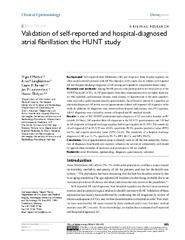| dc.contributor.author | Malmo, Vegard | |
| dc.contributor.author | Langhammer, Arnulf | |
| dc.contributor.author | Bønaa, Kaare | |
| dc.contributor.author | Loennechen, Jan Pål | |
| dc.contributor.author | Ellekjær, Hanne | |
| dc.date.accessioned | 2016-08-24T08:03:44Z | |
| dc.date.available | 2016-08-24T08:03:44Z | |
| dc.date.issued | 2016-06-11 | |
| dc.description.abstract | Background: Self-reported atrial fibrillation (AF) and diagnoses from hospital registers are often used to identify persons with AF. The objective of this study was to validate self-reported AF and hospital discharge diagnoses of AF among participants in a population-based study.
Materials and methods: Among 50,805 persons who participated in the third survey of the HUNT Study (HUNT3), 16,247 participants from three municipalities were included. Individuals who reported cardiovascular disease, renal disease, or hypertension in the main questionnaire received a cardiovascular-specific questionnaire. An affirmative answer to a question on physician-diagnosed AF in this second questionnaire defined self-reported AF diagnoses in the study. In addition, AF diagnoses were retrieved from hospital and primary care (PC) registers. All AF diagnoses were verified by review of hospital and PC medical records.
Results: A total of 502 HUNT3 participants had a diagnosis of AF verified in hospital or PC records. Of these, 249 reported their AF diagnosis in the HUNT3 questionnaires and 370 had an AF diagnosis in hospital discharge registers before participation in HUNT3. The sensitivity of self-reported AF in HUNT3 was 49.6%, specificity 99.2%, positive predictive value (PPV) 66.2%, and negative predictive value (NPV) 98.4%. The sensitivity of a hospital discharge diagnosis of AF was 73.7%, specificity 99.7%, PPV 88.5%, and NPV 99.2%.
Conclusion: Use of questionnaires alone to identify cases of AF has low sensitivity. Extraction of diagnoses from health care registers enhances the sensitivity substantially and should be applied when estimates of incidence and prevalence of AF are studied. | en_US |
| dc.description.sponsorship | This study was supported by grants from the Norwegian Council on Cardiovascular Diseases, the Liaison Committee between the Central Norway Regional Health Authority and the Norwegian University of Science and Technology, and the Department of Neuroscience at the Norwegian University of Science and Technology. | en_US |
| dc.description | Publisher's version, source <a href=http://doi.org/10.2147/CLEP.S103346>http://doi.org/10.2147/CLEP.S103346</a> | en_US |
| dc.identifier.citation | Clinical Epidemiology 2016:8 185–193 | en_US |
| dc.identifier.cristinID | FRIDAID 1368397 | |
| dc.identifier.doi | 10.2147/CLEP.S103346 | |
| dc.identifier.issn | 1179-1349 | |
| dc.identifier.uri | https://hdl.handle.net/10037/9523 | |
| dc.identifier.urn | URN:NBN:no-uit_munin_9084 | |
| dc.language.iso | eng | en_US |
| dc.publisher | Dove Medical Press | en_US |
| dc.rights.accessRights | openAccess | |
| dc.subject | VDP::Medisinske Fag: 700::Helsefag: 800::Epidemiologi medisinsk og odontologisk statistikk: 803 | en_US |
| dc.subject | atrial fibrillation | en_US |
| dc.subject | epidemiology | en_US |
| dc.subject | diagnosis | en_US |
| dc.subject | questionnaire | en_US |
| dc.subject | validation | en_US |
| dc.title | Validation of self-reported and hospital-diagnosed atrial fibrillation: The HUNT study | en_US |
| dc.type | Journal article | en_US |
| dc.type | Tidsskriftartikkel | en_US |
| dc.type | Peer reviewed | en_US |


 English
English norsk
norsk